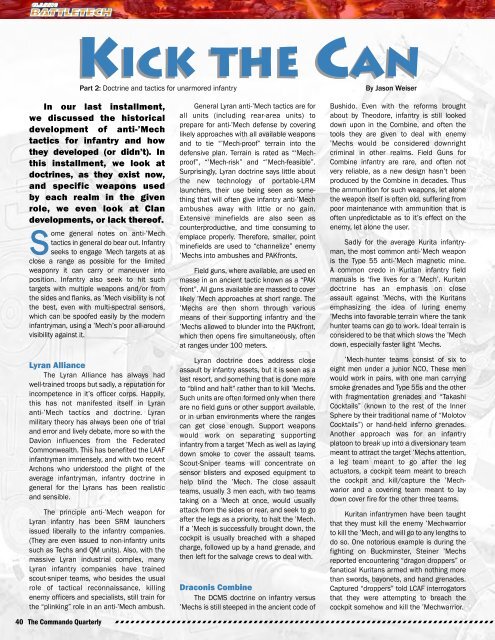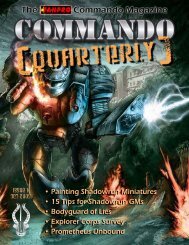Commando Quarterly 1st Quarter 2006 - low res
Commando Quarterly 1st Quarter 2006 - low res
Commando Quarterly 1st Quarter 2006 - low res
Create successful ePaper yourself
Turn your PDF publications into a flip-book with our unique Google optimized e-Paper software.
In our last installment,<br />
we discussed the historical<br />
development of anti-’Mech<br />
tactics for infantry and how<br />
they developed (or didn’t). In<br />
this installment, we look at<br />
doctrines, as they exist now,<br />
and specific weapons used<br />
by each realm in the given<br />
role, we even look at Clan<br />
developments, or lack thereof.<br />
Some general notes on anti-’Mech<br />
tactics in general do bear out. Infantry<br />
seeks to engage ’Mech targets at as<br />
close a range as possible for the limited<br />
weaponry it can carry or maneuver into<br />
position. Infantry also seek to hit such<br />
targets with multiple weapons and/or from<br />
the sides and flanks, as ’Mech visibility is not<br />
the best, even with multi-spectral sensors,<br />
which can be spoofed easily by the modern<br />
infantryman, using a ’Mech’s poor all-around<br />
visibility against it.<br />
Lyran Alliance<br />
The Lyran Alliance has always had<br />
well-trained troops but sadly, a reputation for<br />
incompetence in it’s officer corps. Happily,<br />
this has not manifested itself in Lyran<br />
anti-’Mech tactics and doctrine. Lyran<br />
military theory has always been one of trial<br />
and error and lively debate, more so with the<br />
Davion influences from the Federated<br />
Commonwealth. This has benefited the LAAF<br />
infantryman immensely, and with two recent<br />
Archons who understood the plight of the<br />
average infantryman, infantry doctrine in<br />
general for the Lyrans has been realistic<br />
and sensible.<br />
The principle anti-’Mech weapon for<br />
Lyran infantry has been SRM launchers<br />
issued liberally to the infantry companies.<br />
(They are even issued to non-infantry units<br />
such as Techs and QM units). Also, with the<br />
massive Lyran industrial complex, many<br />
Lyran infantry companies have trained<br />
scout-sniper teams, who besides the usual<br />
role of tactical reconnaissance, killing<br />
enemy officers and specialists, still train for<br />
the “plinking” role in an anti-’Mech ambush.<br />
40 The <strong>Commando</strong> <strong><strong>Quarter</strong>ly</strong><br />
KICK THE CAN<br />
Part 2: Doctrine and tactics for unarmored infantry By Jason Weiser<br />
General Lyran anti-’Mech tactics are for<br />
all units (including rear-area units) to<br />
prepare for anti-’Mech defense by covering<br />
likely approaches with all available weapons<br />
and to tie “’Mech-proof” terrain into the<br />
defensive plan. Terrain is rated as “‘Mechproof”,<br />
“’Mech-risk” and “’Mech-feasible”.<br />
Surprisingly, Lyran doctrine says little about<br />
the new technology of portable-LRM<br />
launchers, their use being seen as something<br />
that will often give infantry anti-’Mech<br />
ambushes away with little or no gain.<br />
Extensive minefields are also seen as<br />
counterproductive, and time consuming to<br />
emplace properly. Therefore, smaller, point<br />
minefields are used to “channelize” enemy<br />
’Mechs into ambushes and PAKfronts.<br />
Field guns, where available, are used en<br />
masse in an ancient tactic known as a “PAK<br />
front”. All guns available are massed to cover<br />
likely ’Mech approaches at short range. The<br />
’Mechs are then shorn through various<br />
means of their supporting infantry and the<br />
’Mechs al<strong>low</strong>ed to blunder into the PAKfront,<br />
which then opens fire simultaneously, often<br />
at ranges under 100 meters.<br />
Lyran doctrine does add<strong>res</strong>s close<br />
assault by infantry assets, but it is seen as a<br />
last <strong>res</strong>ort, and something that is done more<br />
to “blind and halt” rather than to kill ’Mechs.<br />
Such units are often formed only when there<br />
are no field guns or other support available,<br />
or in urban environments where the ranges<br />
can get close enough. Support weapons<br />
would work on separating supporting<br />
infantry from a target ’Mech as well as laying<br />
down smoke to cover the assault teams.<br />
Scout-Sniper teams will concentrate on<br />
sensor blisters and exposed equipment to<br />
help blind the ’Mech. The close assault<br />
teams, usually 3 men each, with two teams<br />
taking on a ’Mech at once, would usually<br />
attack from the sides or rear, and seek to go<br />
after the legs as a priority, to halt the ’Mech.<br />
If a ’Mech is successfully brought down, the<br />
cockpit is usually breached with a shaped<br />
charge, fol<strong>low</strong>ed up by a hand grenade, and<br />
then left for the salvage crews to deal with.<br />
Draconis Combine<br />
The DCMS doctrine on infantry versus<br />
’Mechs is still steeped in the ancient code of<br />
Bushido. Even with the reforms brought<br />
about by Theodore, infantry is still looked<br />
down upon in the Combine, and often the<br />
tools they are given to deal with enemy<br />
’Mechs would be considered downright<br />
criminal in other realms. Field Guns for<br />
Combine infantry are rare, and often not<br />
very reliable, as a new design hasn’t been<br />
produced by the Combine in decades. Thus<br />
the ammunition for such weapons, let alone<br />
the weapon itself is often old, suffering from<br />
poor maintenance with ammunition that is<br />
often unpredictable as to it’s effect on the<br />
enemy, let alone the user.<br />
Sadly for the average Kurita infantryman,<br />
the most common anti-’Mech weapon<br />
is the Type 55 anti-’Mech magnetic mine.<br />
A common credo in Kuritan infantry field<br />
manuals is ‘five lives for a ’Mech’. Kuritan<br />
doctrine has an emphasis on close<br />
assault against ’Mechs, with the Kuritans<br />
emphasizing the idea of luring enemy<br />
’Mechs into favorable terrain where the tank<br />
hunter teams can go to work. Ideal terrain is<br />
considered to be that which s<strong>low</strong>s the ’Mech<br />
down, especially faster light ’Mechs.<br />
’Mech-hunter teams consist of six to<br />
eight men under a junior NCO, These men<br />
would work in pairs, with one man carrying<br />
smoke grenades and Type 55s and the other<br />
with fragmentation grenades and “Takashi<br />
Cocktails” (known to the <strong>res</strong>t of the Inner<br />
Sphere by their traditional name of “Molotov<br />
Cocktails”) or hand-held inferno grenades.<br />
Another approach was for an infantry<br />
platoon to break up into a diversionary team<br />
meant to attract the target ’Mechs attention,<br />
a leg team meant to go after the leg<br />
actuators, a cockpit team meant to breach<br />
the cockpit and kill/capture the ’Mechwarior<br />
and a covering team meant to lay<br />
down cover fire for the other three teams.<br />
Kuritan infantrymen have been taught<br />
that they must kill the enemy ’Mechwarrior<br />
to kill the ’Mech, and will go to any lengths to<br />
do so. One notorious example is during the<br />
fighting on Buckminster, Steiner ’Mechs<br />
reported encountering “dragon droppers” or<br />
fanatical Kuritans armed with nothing more<br />
than swords, bayonets, and hand grenades.<br />
Captured “droppers” told LCAF interrogators<br />
that they were attempting to breach the<br />
cockpit somehow and kill the ’Mechwarrior.<br />
I I I I I I I I I I I I I I I I I I I I I I I I I I I I I I I I I I I I I I I I I I I I I I I I I I I I I I I I I I I I I I I I I I I I I I I I I I




